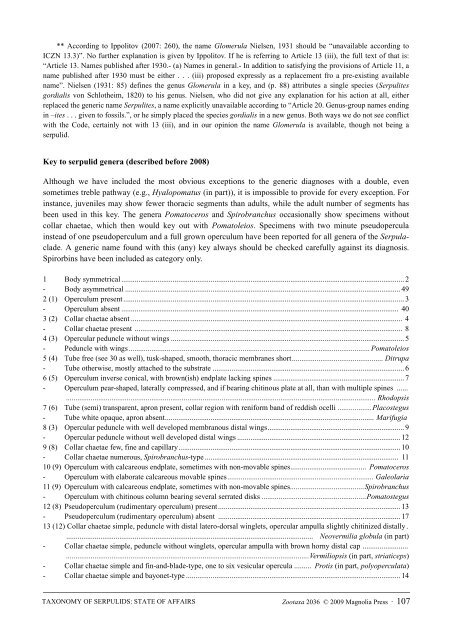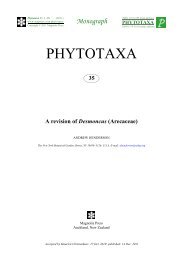Zootaxa, Taxonomy of Serpulidae (Annelida ... - Magnolia Press
Zootaxa, Taxonomy of Serpulidae (Annelida ... - Magnolia Press
Zootaxa, Taxonomy of Serpulidae (Annelida ... - Magnolia Press
You also want an ePaper? Increase the reach of your titles
YUMPU automatically turns print PDFs into web optimized ePapers that Google loves.
** According to Ippolitov (2007: 260), the name Glomerula Nielsen, 1931 should be “unavailable according to<br />
ICZN 13.3)”. No further explanation is given by Ippolitov. If he is referring to Article 13 (iii), the full text <strong>of</strong> that is:<br />
“Article 13. Names published after 1930.- (a) Names in general.- In addition to satisfying the provisions <strong>of</strong> Article 11, a<br />
name published after 1930 must be either . . . (iii) proposed expressly as a replacement fro a pre-existing available<br />
name”. Nielsen (1931: 85) defines the genus Glomerula in a key, and (p. 88) attributes a single species (Serpulites<br />
gordialis von Schlotheim, 1820) to his genus. Nielsen, who did not give any explanation for his action at all, either<br />
replaced the generic name Serpulites, a name explicitly unavailable according to “Article 20. Genus-group names ending<br />
in –ites . . . given to fossils.”, or he simply placed the species gordialis in a new genus. Both ways we do not see conflict<br />
with the Code, certainly not with 13 (iii), and in our opinion the name Glomerula is available, though not being a<br />
serpulid.<br />
Key to serpulid genera (described before 2008)<br />
Although we have included the most obvious exceptions to the generic diagnoses with a double, even<br />
sometimes treble pathway (e.g., Hyalopomatus (in part)), it is impossible to provide for every exception. For<br />
instance, juveniles may show fewer thoracic segments than adults, while the adult number <strong>of</strong> segments has<br />
been used in this key. The genera Pomatoceros and Spirobranchus occasionally show specimens without<br />
collar chaetae, which then would key out with Pomatoleios. Specimens with two minute pseudopercula<br />
instead <strong>of</strong> one pseudoperculum and a full grown operculum have been reported for all genera <strong>of</strong> the Serpulaclade.<br />
A generic name found with this (any) key always should be checked carefully against its diagnosis.<br />
Spirorbins have been included as category only.<br />
1 Body symmetrical ..................................................................................................................................................... 2<br />
- Body asymmetrical ................................................................................................................................................. 49<br />
2 (1) Operculum present.................................................................................................................................................... 3<br />
- Operculum absent .................................................................................................................................................. 40<br />
3 (2) Collar chaetae absent ............................................................................................................................................... 4<br />
- Collar chaetae present ............................................................................................................................................. 8<br />
4 (3) Opercular peduncle without wings ........................................................................................................................... 5<br />
- Peduncle with wings ............................................................................................................................... Pomatoleios<br />
5 (4) Tube free (see 30 as well), tusk-shaped, smooth, thoracic membranes short................................................ Ditrupa<br />
- Tube otherwise, mostly attached to the substrate ..................................................................................................... 6<br />
6 (5) Operculum inverse conical, with brown(ish) endplate lacking spines ..................................................................... 7<br />
- Operculum pear-shaped, laterally compressed, and if bearing chitinous plate at all, than with multiple spines ......<br />
................................................................................................................................................................... Rhodopsis<br />
7 (6) Tube (semi) transparent, apron present, collar region with reniform band <strong>of</strong> reddish ocelli ..................Placostegus<br />
- Tube white opaque, apron absent.............................................................................................................. Marifugia<br />
8 (3) Opercular peduncle with well developed membranous distal wings........................................................................ 9<br />
- Opercular peduncle without well developed distal wings ...................................................................................... 12<br />
9 (8) Collar chaetae few, fine and capillary..................................................................................................................... 10<br />
- Collar chaetae numerous, Spirobranchus-type ...................................................................................................... 11<br />
10 (9) Operculum with calcareous endplate, sometimes with non-movable spines........................................ Pomatoceros<br />
- Operculum with elaborate calcareous movable spines ............................................................................. Galeolaria<br />
11 (9) Operculum with calcareous endplate, sometimes with non-movable spines.......................................Spirobranchus<br />
- Operculum with chitinous column bearing several serrated disks .......................................................Pomatostegus<br />
12 (8) Pseudoperculum (rudimentary operculum) present................................................................................................ 13<br />
- Pseudoperculum (rudimentary operculum) absent ................................................................................................ 17<br />
13 (12) Collar chaetae simple, peduncle with distal latero-dorsal winglets, opercular ampulla slightly chitinized distally.<br />
.................................................................................................................................. Neovermilia globula (in part)<br />
- Collar chaetae simple, peduncle without winglets, opercular ampulla with brown horny distal cap ........................<br />
................................................................................................................................Vermiliopsis (in part, striaticeps)<br />
- Collar chaetae simple and fin-and-blade-type, one to six vesicular opercula ......... Protis (in part, polyoperculata)<br />
- Collar chaetae simple and bayonet-type ................................................................................................................. 14<br />
TAXONOMY OF SERPULIDS: STATE OF AFFAIRS<br />
<strong>Zootaxa</strong> 2036 © 2009 <strong>Magnolia</strong> <strong>Press</strong> · 107
















